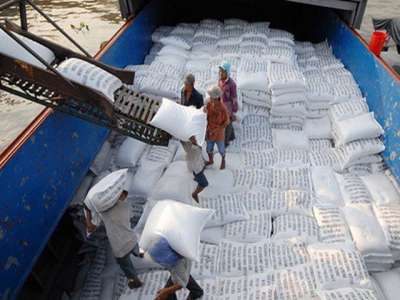Vietnam shifts to export high-quality rice

Vietnam is trying to re-position itself as an exporter of high-quality rice instead of low-quality white rice.
Vietnam is a big rice exporter in the world
A report from Tran Thanh Hai, deputy director of the Ministry of Industry and Trade’s (MOIT) Import/Export Department, released at a workshop in early November, showed big changes in Vietnam’s rice exports structure.
More high-quality and fragrant rice has been exported, while the low- and medium-quality white rice volume has decreased.
The white low-quality rice exports in 2017 accounted for 3.88 percent of total rice exports, while white medium-quality rice was 8.24 percent. Meanwhile, fragrant rice of different kinds amounted to 29.2 percent, white high-quality was 24.3 percent, sticky rice 23.5 percent and Japonica 4.4 percent.
The white low-quality rice exports in 2017 accounted for 3.88 percent of total rice exports, while white medium-quality rice was 8.24 percent. Meanwhile, fragrant rice of different kinds amounted to 29.2 percent, white high-quality was 24.3 percent, sticky rice 23.5 percent and Japonica 4.4 percent.
The Ministry of Agriculture and Rural Development (MARD) requested localities to step up the production of high-quality rice varieties and fragrant rice in the 2017-2018 winter-spring crop.
However, analysts predicted that the proportion of white low- and medium-quality rice in 2018 would increase significantly because of the return of traditional markets – Indonesia and the Philippines, which mostly consume medium-quality products.
According to Hai, Vietnamese enterprises have signed contracts on exporting 700,000 tons of rice to Indonesia so far this year. As for the Philippine market, the figure has reached 130,000 tons. Vietnam also plans to export 400,000 tons of rice under government-to-government and commercial contracts.
The increase in the contracted amounts of low-quality rice exports has created a ‘fever’ of IR 50404, the variety that produces low- and medium-quality rice in Mekong Delta.
Pham Quang Dieu, CEO of Agrimonitor, a market analysis firm, quoted experts as saying that rice is influenced by politics and complicated import markets.
Also according to Dieu, as Vietnam is trying to leave the low- and medium-quality rice market segment and increase exports of fragrant rice, the demand for low- and medium-quality rice has unexpectedly bounced back with the return of Indonesia and the Philippines.
The sharp rise in demand has made the white rice price increase rapidly with the price nearly hitting the price of the high-quality OM 5451.
“I believe that what to grow is a difficult question for management agencies and those who want to create higher added value for rice production,” Dieu said.
Agriculture experts have repeatedly urged MARD and relevant agencies to encourage the production of high quality rice, saying that low-quality exports cannot bring high profit to farmers. Vietnam is still not a strong rice brand in the world market, though it is one of the biggest rice exporters.
In 2010-2016, Vietnam’s rice accounted for 15 percent of total exports globally.
Có thể bạn quan tâm
 3% annual growth for agriculture by 2020: Ministry
3% annual growth for agriculture by 2020: Ministry Việt Nam’s agriculture sector is aiming for annual growth of a minimum 3 per cent, with labour productivity improving 3.5 per cent a year by 2020
 Over US$140 million spent monthly on importing fruit and vegetables
Over US$140 million spent monthly on importing fruit and vegetables Vietnam spent more than US$1.43 billion on importing fruit and vegetables during the first 10 months of 2018, a year-on-year rise of 13.1%
 Hi-tech agriculture grows up in Ba Ria-Vung Tau
Hi-tech agriculture grows up in Ba Ria-Vung Tau High-tech agriculture will create a large volume of goods with high productivity and good quality, meeting the increasing demand of the market